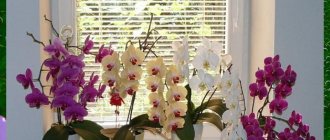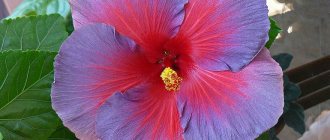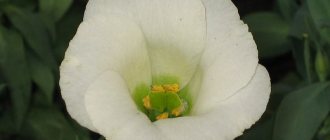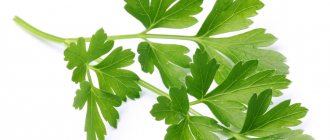Tradescantia belongs to the Commelinaceae . Widely distributed in nature in America.
The plant received its name in honor of the gardener John Tradescant, who served Charles I and was the first to describe this genus.
The plant belongs to the ampelous species and has creeping or straight stems. Tradescantia is very popular among flower growers due to its unpretentiousness and ease of forming and obtaining an attractive bush.
Tradescantia is also known for its beneficial properties, its ability to purify the air and neutralize electromagnetic radiation.
Selected types of Tradescantia:
Tradescantia zebrina, hanging.
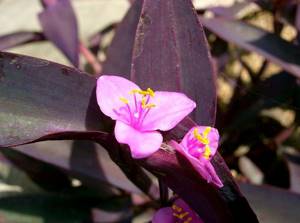
Setcreasea or Tradescantia Pallida.
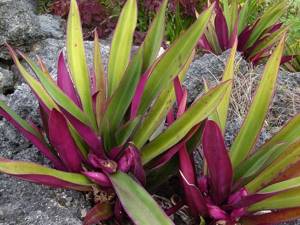
Reo or Tradescantia variegated
About caring for Tradescantia
Temperature: In spring and summer, a moderate temperature of 22-25°C is optimal; in winter it will withstand temperatures of at least 12°C. Tradescantia overwinters quietly even at normal room temperatures, if all care rules are followed.
Lighting: Prefers bright, diffused lighting, can withstand light shading. Variegated varieties are grown only in good light conditions, otherwise the color may suffer. Tradescantia is most suitable for eastern and western windows; varieties with monochromatic leaves also do well on northern windows. In summer, the plant can be moved to the garden, terrace or balcony, but you should choose a place well protected from direct sunlight and precipitation.
Watering: Tradescantia prefers abundant watering during the entire period of active growth from early spring to late summer, immediately after the top layer of soil dries out. Excess moisture from the pan is immediately drained. In winter, if the temperature is low, watering is reduced and done only after the soil for watering should be soft and settled.
Air humidity: Does not require high air humidity, does not require regular spraying. Grows well at normal humidity levels in apartments. In summer, it is recommended to give the plant a warm shower from time to time and spray it with a spray bottle.
Fertilizers : Apply special fertilizers for decorative deciduous plants 2 times a month. Varieties with monochromatic leaves are alternately fertilized with organic fertilizer. Variegated tradescantia are not fertilized with organic matter.
Soil: The plant is grown in special soil for tradescantia or for decorative foliage plants. A little vermiculite and pieces of charcoal are added to the soil, which will protect the roots from rotting.
Transplantation: Carried out together with pruning. Young Tradescantia are replanted annually in the spring, adult specimens once every 2-3 years. A thick layer of drainage is required at the bottom of the pot.
Pests: Can attack scale insects , spider mites , aphids and thrips .
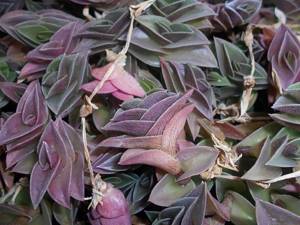
Tradescantia sillamontana. ©David J. Stang
Tradescantia pests and diseases
Tradescantia is resistant to pest attacks and is little susceptible to disease. Nevertheless, the necessary measures should be taken if negative changes are noticed. The red mite sometimes settles on the back side of young leaves. To avoid the appearance of pests, you can periodically water the soil in pots with a solution of tar soap.
If a large number of insects are detected, the plant along with the pot is placed in a plastic bag and the flower itself, the flower pot and the soil are thoroughly treated with an insecticide. The bag should be tied in a knot and the plant should be left in it for 5 days. After this, the processing is repeated. Three-time treatment completely eliminates pests. The area where the pot was located should also be wiped with a napkin moistened with an insecticide solution to avoid re-infection.
Most varieties are tolerant to conditions - they tolerate a lack of light, nutrients, watering, air humidity, and attention from the owner, although their appearance suffers.
Commelinaceae can be kept in hydroponic culture - their roots are quite resistant to the lack of air. To maintain Tradescantia at this content, they should be provided with nutrients by dissolving them in water. This solution is added to the container where they are located.
Types of Tradescantia with photos and names with descriptions
Tradescantia villosa
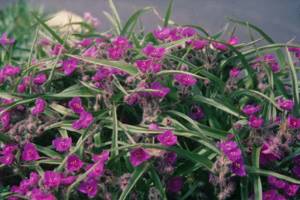
Tradescantia villosa photo
This Tradescantia is easily identified by its leaves covered with silvery pubescence. It is not quite ordinary: it is not only very beautiful, but also a resilient plant that can easily tolerate drought. There are examples of hairy Tradescantia living without water for several weeks. With a lack of moisture, the leaves turn purple and lose their elasticity - as if the plant is freezing. But as soon as a little water gets on the roots, it will come to life and bloom with amazing purple flowers. This flower feels good where other flowers cannot withstand the heat and sun - on the windowsills of southern windows and even next to central heating radiators. In summer you can plant it on the balcony.
White-flowered Tradescantia albiflora
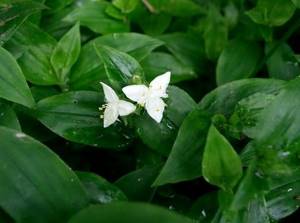
White-flowered Tradescantia albiflora photo planting and care
The stem of the plant is herbaceous, strongly branched. Its malachite leaves are sometimes slightly pubescent, and its flowers are white. To make the bush more picturesque, flowering shoots should be pinched, as flowering is inconspicuous and depletes the plant. The most common form is with leaves mottled with irregular white stripes on a light emerald background. The Laekensis form differs from the previous one in having pink stripes, while Tricolor has both white and pink stripes.
Tradescantia blossfeldiana
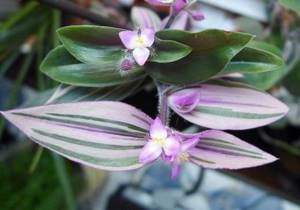
Tradescantia Blossfeldiana Tradescantia blossfeldiana photo
This form has wide, few stripes of yellow and green. With a lack of lighting, inept cuttings or pruning, the beautiful stripes on the leaves can disappear forever.
Tradescantia fluminensis
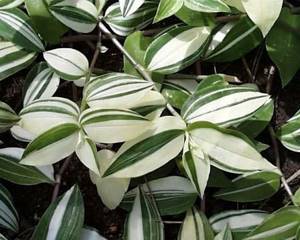
Tradescantia fluminensis variegata photo
This species has frequent light yellow stripes. The creeping shoots of this species have a magnificent purple color with greenish specks.
Tradescantia navicularis Tradescantia navicularis
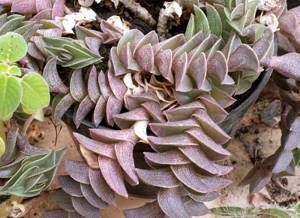
Tradescantia navicularis Tradescantia navicularis photo
A wonderful plant that forms clumps among thickets of cacti on clay soil. It can rightfully be considered a succulent - the supply of moisture is contained in all parts.
Tradescantia sillamontana Tradescantia sillamontana
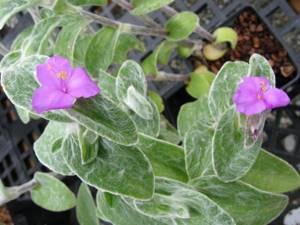
Tradescantia sillamontana Tradescantia sillamontana photo
It is literally shrouded in thick white felt - it is difficult to determine the real color of its leaf plates. Its stems grow vertically, and its leaves are arranged in a spiral. Bright pink flowers are especially impressive against the background of whitish leaves.
Tradescantia virginiana Tradescantia virginiana
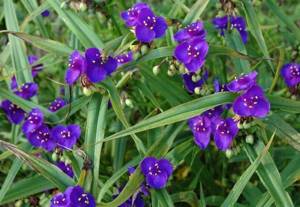
Tradescantia virginiana Tradescantia virginiana photo
It is successfully grown in garden plots as a perennial plant. It has erect stems with ribbon-like leaf blades. It blooms with numerous pink and blue flowers collected in umbels. The fruit is a capsule with opening flaps.
Tradescantia Andersoniana Tradescantia andersoniana
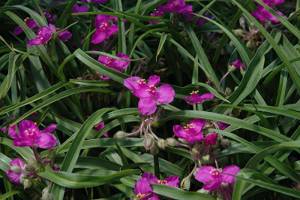
Tradescantia Anderson Tradescantia andersoniana photo
A profusely flowering perennial for flower beds with a straight stem 35-75 cm high. It has many varieties. Garden species of Tradescantia can be easily propagated by cuttings, seeds, or dividing the bush. This operation is carried out at the beginning of the season, slightly trimming the roots, after which the flowers are quickly restored. By propagating by seeds, you can obtain specimens completely different from the parent individual.
This inconspicuous flower has a number of positive qualities.
- The plant is able to cleanse the surrounding atmosphere of negative emissions: tobacco smoke, toxins that emit building materials and furniture.
- Neutralizes the electromagnetic field emitted by home appliances.
- It is actively used in traditional medicine - heals wounds, stops bleeding, relieves inflammation, improves the condition of diabetics.
- Scientists have discovered a substance similar in quality to insulin in the juice of the Zebrina variety of Tradescantia.
- Commeline phytoncides destroy viruses and microbes present in the room.
- Tradescantia humidifies the air, improving the microclimate.
- Pets, especially cats, love to eat juicy leaves. Aquarium fish and birds happily eat crushed leaves.
- It is believed that Tradescantia cleanses the energy field of the house, removes damage and the evil eye, and improves relationships with others. Great for all zodiac signs.
Tradescantia was one of the first representatives of the plant world to travel into space, traveling on a satellite. This beautiful and useful plant brings many positive emotions to its owners.
Formation of the Tradescantia crown:
A prerequisite for growing is pruning Tradescantia. Without this type of care, it will quickly grow, stretch out and lose its attractive appearance. In the spring, after transplantation, all shoots of the plant are pinched, and those that are very elongated are cut to the required length.
Specimens that do not need replanting are cut and pinched in the same spring.
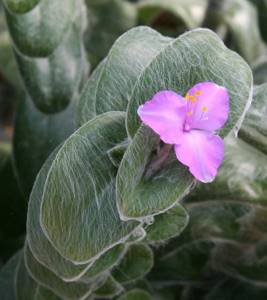
Tradescantia sillamontana. ©Michael Wolf
Climbing indoor plants - the secret is moderation
In order for Tradescantia to feel good, quickly increase the length of the lashes and produce lush foliage, you need a little. Many climbing indoor plants, in general, adapt to any conditions: good light, shade, increased heat, and coolness. Tradescantia is one of them. You could even say that she is the leader of unpretentious indoor plants. For example, it seems that the quality of the soil in which it grows does not bother her at all. Although, of course, light soil, with peat and sand, welcomes all climbing and non-climbing plants.
Tradescantia is clearly not indifferent to water - just like any plant that is a climbing indoor plant. In principle, it will survive irregular watering, even long-term, but then growth will stop, and the lashes will dry out one after another.
It must be borne in mind that tradescantia with beautiful variegated colors require more attention: due to lack of lighting and water, they can lose their decorative effect and turn into “green leaves”.
New plants are grown from vine shoots: shoots with thickened nodes easily take root in water, after which they are planted in the ground.
Methods for propagating Tradescantia at home
Seed propagation:
The seeds are sown in early spring on pre-moistened special soil for decorative foliage plants. The seeds are not deeply buried, covered with a greenhouse and placed in a bright, warm place at 20°C. In order for seedlings to appear as quickly as possible, the temperature must be stable, the greenhouse must be regularly ventilated and the soil must always be kept moist using a spray bottle.
Young Tradescantia must be protected from excessive waterlogging and drafts, since their root system is initially poorly developed. With proper care, they can bloom already in the 3rd year of life.
Cuttings, parts of the stem:
The fastest effective and optimal method of propagating tradescantia, which can be used at any time of the year. Typically, flower growers use cuttings obtained by pruning the plant in the spring for propagation. For successful rooting, the cutting must be 10-15 cm long; if it is longer, it can be divided into parts.
Cuttings quickly take root at a temperature of 15-20 °C both in water with the addition of activated carbon and in soil. 5-7 cuttings are planted in one pot at once in order to get a lush bush as quickly as possible.
Bush division:
Well-grown Tradescantia can be divided into parts. Such division is carried out only during transplantation, carefully, trying not to damage the roots once again, dividing the bush into parts with your hands. Each specimen is planted in a separate container and placed in place with the optimal temperature and absence of drafts.
Tradescantia navicularis. ©Salicyna
Brief description of the plant
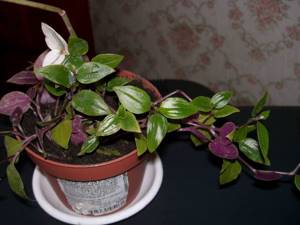
Indoor Tradescantia species bloom very rarely, usually in late spring or early summer. The plant has a number of beneficial properties that allow it to be used as a medicinal product. In indoor conditions, this flower cleanses the air of dust, tobacco smoke and other harmful compounds . Phytoncides found in the plant destroy viruses and microbes. These microorganisms are the causative agents of many diseases. The plant is considered unpretentious, so caring for a Tradescantia flower at home is not difficult.
Codiaum excelent: care at home
Growing problems:
- Yellow spots on the leaves appear when there is a lack of moisture in the soil;
- Sluggish shoots - insufficient watering;
- The variegated variety loses color if the plant does not have enough light intensity;
- Lack of growth, shoots stretch, leaves thin out due to lack of water, fertilizers, light;
- The tips of the leaves turn brown if the indoor humidity is too low;
- The leaves dry out and fall off at the base of the stem - the plant should be rejuvenated.
Views: 271
